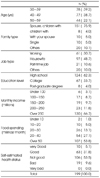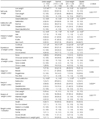Abstract
This study was carried out to investigate distribution of obesity, body composition, weight control and dietary behaviors, and to analyze the relationship between Body Mass Index (BMI) and physical characteristics, body composition and dietary behaviors by anthropmetric measurement and questionnaires. The 199 study subjects were divided into 3 age groups; 30's (78), 40's (77) and 50's (44) and 4 groups by BMI ; under weight (4.5%), normal (51.3%), over weight (26.1%) and obese (18.1%). Amount of skeletal muscle, body water, mineral and body fat were significantly increased with BMI. There were especially significant increase skeletal muscle 5.3 kg (19.1 → 23.5 kg), body water 5.3 kg (26.3 → 31.6 kg) and fat 15.2 kg (11.2 → 26.4 kg) from under weight to obesity group, respectively (p < 0.01). There were significantly decreased in the ratio of body water (10.3%), protein (2.7%) and body mineral (1.1%) from under weight to obesity, but significant increase 14.1% in body fat (p < 0.001). About 44.4% of under weight group and 40.1% of normal group and 50% of over and obesity group had dissatisfaction on their body images. Most of the women were concerned about their body images and experienced weight control. Dietary behavior scores of obesity group were significant lower than the other four groups (p < 0.001). There were significant positive correlation between BMI and body water (r = 0.62), protein (r = 0.52), skeletal muscle (r = 0.63), body fat (r = 0.91) and WH ratio (r = 0.91), respectively (p < 0.001). The correlation between BMI and body fat and WH ratio were much higher than the correlation between weight and fat and WH ratio.
Figures and Tables
Table 5
Mean of Obesity behavior in each group by BMI

1) The lowes score means having more obesity tendency (Yes : 1, Mostly Yes: 2 Normal: 3, Mostly Not: 4, No: 5)
2) Means with superscripts (a> b) within a row are significantly from each at p = 0.05 by Duncan's multiple range test.
3) Significance as determined by GLM test
*: p < 0.05, **: p < 0.01, ***: p < 0.001
References
1. Balkau B, Deanfield JE, Desprs JP, Bassand JP, Fox KAA, Smith SC, Barter P, Tan CE, Gaal LV, Wittchen HU, Massien C, Haffner SM. International Day for the Evaluation of Abdominal obesity (IDEA): A study of waist circumference, cardiovascular disease, and diabetes mellitus in 168,000 primary care patients in 63 countries. Circulation. 2007. 116(17):1942–1951.
2. Biospace. User's manual (Inbody 230). 2008. Seoul: Biospace Co., Ltd.
3. Chang HS. A study on weight control behavior, eating habits and health-related life habits according to obesity degree by body fat percentage among middle-aged women in Gunsan city. Korean J Community Nutr. 2010. 15(2):227–239.
4. Haroun D, Taylor SJC, Viner RM, Hayward RS, Darch TS, Eaton S, Cole TJ, Wells JCK. Validation of bioelectrical impedance analysis in adolescents across different ethnic groups. Obesity. 2010. 18:1252–1259.
5. Heymsfield S, Loham T, Wang Z-M, Going S. Body composition second edition. 2005. USA: Human Kinetics;18.
6. Hwang IC, Jo YM, Kim KK. The usefulness of waist to hip ratio estimated by bioelectric impedance analysis in diagnosing metabolic syndrome based on NCEP-ATP III guideline. Korean J Obes. 2009. 18(3):79–86.
7. Jang MR, Kim MH. Job satisfaction of dietitians between elementary school and high school. J Korean Diet Assoc. 2003. 9(1):13–21.
8. Jensen MD. Role of body fat distribution and the metabolic complications of obesity. J Clin Endocrinol Metab. 2008. 93:11 Suppl 1. S57–S63.
9. Kang JK. Lifestyle disease. J Korean Med Assoc. 2004. 47(3):188–194.
10. Kim HS. Evaluation of simple methods to estimate body composition in female. J Korean Soc Study Obes. 2002. 11(4):398–405.
11. Kim MS, Ahn HS. Dietary intakes and serum component in middle aged abdominal obese women. J Korean Soc Study Obes. 2003. 12(2):124–136.
12. Kim YH, Kim Y. A study on body mass index and associated factors of the middle aged women in small city. Korean J Community Nutr. 2002. 7(4):506–515.
13. Kim YH, Ou SW, Kim YS, Chun JH, Yang J, Yoon YS, Lee ES. The factors affecting the fat distribution in the abdomen of obese women. Korean J Obes. 2005. 14(1):39–46.
14. Kim YJ. Comarisons of obesity-related psychosocial factors and food behavior according to percentage of body fat among adolescent girls. 1998. graduate School of Suwon University: MS thesis.
15. Koo JO, Park SY. Analysis of BMI menopose, blood pressure and dietary habits affecting born mineral density of 30~60 years women. Korean J Community Nutr. 2010. 15(3):403–414.
16. Major health issue in Korea. Korea Centers for Disease Control & Prevention. 2007. cited 2011 Jun 20. Available from http://www.mohw.go.kr/front/al/sal0301vw.jsp.
17. The statistics of life table 2008. Korean National Statistical Office. 2009. cited 2011 March 1. Available from http://www.kosis.kr.
18. Korean women's health conditions and policy agenda. Korean Women's Development Institute. 2008. cited 2011 Jun. Available from http://www.kwdi.re.kr/.
19. Kuczmarski MF, Kuczmarski RJ, Najjar M. Effects of age on validity of self-reported height, weight, and body mass index: Findings from the third National Health and Nutrition Examination Survey. J Am Diet Assoc. 2001. 101(1):28–34.
20. Lee SE, Jung YM, Jung KS. A study on the validation of somatotype drawing as a instrument of measuring obesity level by body component analysis. J Korea Community Health Nurs Acad Soc. 2004. 18(2):299–311.
21. Lee HJ, Choi MR, Koo JO. A study of body image, weight control and dietary habits with different BMI in female high school students. Korean J Community Nutr. 2005. 10(6):805–813.
22. Legido A, Sarria A, Bueno M, Garagorri J, Fleta J, Ramos F, Abos MD, Perez-Gonzalez J. Relationship of body fat distribution to metabolic complications in obese prepubertal boys: gender related differences. Acta Paediatr Scand. 1989. 78(3):440–446.
23. Lukaski HC, Johnson PE, Bolonchuk WW, Lykken GI. Assessment of fat-free mass using bioelectrical impedance measurements of the human body. Am J Clin Nutr. 1985. 41(4):810–817.
24. Major chronic disease management business information. Ministry of Health & Welfare. 2010. cited 2011 March 1. Available from http://www.kwdi.re.kr/.
25. Insured health promotion business model development. National Health Insurance Corporation. 2009. cited 2011 Jun 1. Available from http://www.nhic.or.kr/portal/site/main/menuitem.
26. Oh YA, Shim KW, Lee HS, Lee SW, Kim SA. Correlation between abdominal fat measured by bia and fat. Korean J Clin Geriatr. 2006. 7(2):225–237.
27. Park SY. Nutritional status of anemic adolescent females, screening tools and the effect of nutrition education on improvement of iron status. 2002. graduate school of Catholic University;MS thesis.
28. Sharpe JK, Byrne NM, Stedman TJ, Hills AP. Bioelectric impedance is a better indicator of obesity in men with schizophrenia than body mass index. Psychiatry Res. 2008. 159(1-2):121–126.
29. Son SM, Lee JH, Yim KS, Cho YO. Diet & body shaping. 2006. Seoul: Kyomunsa;17.
30. Stamler J. The Intersalt study: background, method, findings, and implications. Am J Clin Nutr. 1997. 65:2 Suppl. 626S–642S.
31. Whitney EN, Pinna K, Rolfes SR. Understanding normal and clinical nutrition. 2002. USA: Wadsworth;254.




 PDF
PDF ePub
ePub Citation
Citation Print
Print








 XML Download
XML Download